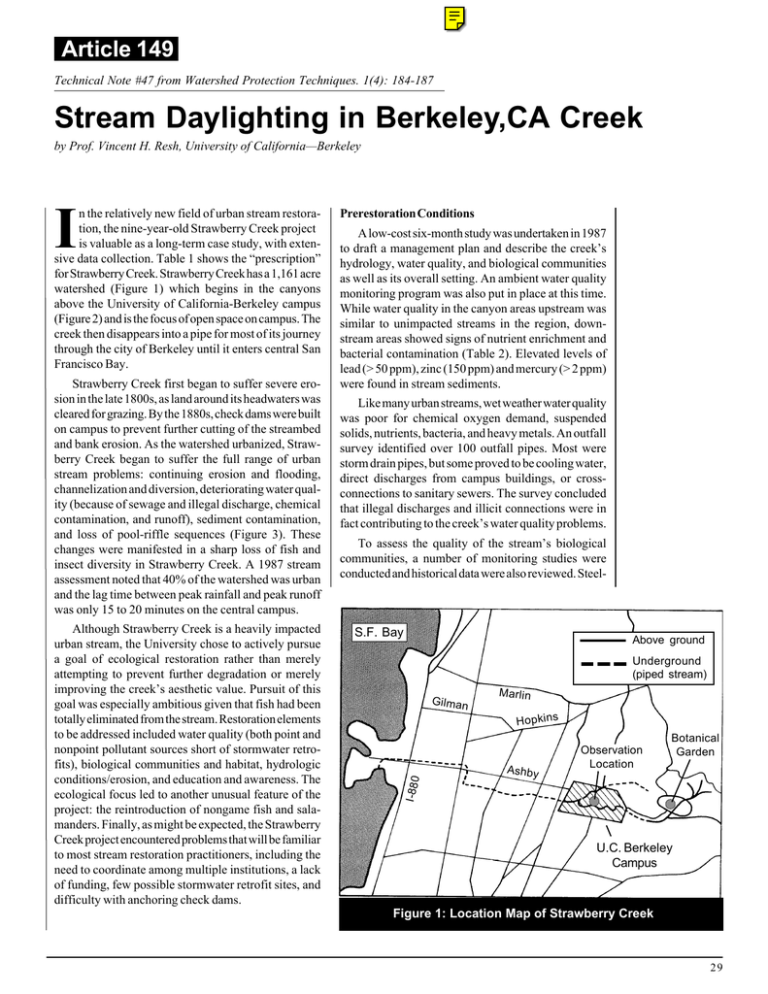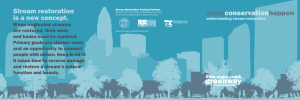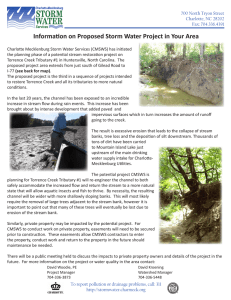Article 149: Stream Daylighting in Berkeley, CA Creek
advertisement

Article 149 Technical Note #47 from Watershed Protection Techniques. 1(4): 184-187 Stream Daylighting in Berkeley,CA Creek by Prof. Vincent H. Resh, University of California—Berkeley Strawberry Creek first began to suffer severe erosion in the late 1800s, as land around its headwaters was cleared for grazing. By the 1880s, check dams were built on campus to prevent further cutting of the streambed and bank erosion. As the watershed urbanized, Strawberry Creek began to suffer the full range of urban stream problems: continuing erosion and flooding, channelization and diversion, deteriorating water quality (because of sewage and illegal discharge, chemical contamination, and runoff), sediment contamination, and loss of pool-riffle sequences (Figure 3). These changes were manifested in a sharp loss of fish and insect diversity in Strawberry Creek. A 1987 stream assessment noted that 40% of the watershed was urban and the lag time between peak rainfall and peak runoff was only 15 to 20 minutes on the central campus. Although Strawberry Creek is a heavily impacted urban stream, the University chose to actively pursue a goal of ecological restoration rather than merely attempting to prevent further degradation or merely improving the creek’s aesthetic value. Pursuit of this goal was especially ambitious given that fish had been totally eliminated from the stream. Restoration elements to be addressed included water quality (both point and nonpoint pollutant sources short of stormwater retrofits), biological communities and habitat, hydrologic conditions/erosion, and education and awareness. The ecological focus led to another unusual feature of the project: the reintroduction of nongame fish and salamanders. Finally, as might be expected, the Strawberry Creek project encountered problems that will be familiar to most stream restoration practitioners, including the need to coordinate among multiple institutions, a lack of funding, few possible stormwater retrofit sites, and difficulty with anchoring check dams. Prerestoration Conditions A low-cost six-month study was undertaken in 1987 to draft a management plan and describe the creek’s hydrology, water quality, and biological communities as well as its overall setting. An ambient water quality monitoring program was also put in place at this time. While water quality in the canyon areas upstream was similar to unimpacted streams in the region, downstream areas showed signs of nutrient enrichment and bacterial contamination (Table 2). Elevated levels of lead (> 50 ppm), zinc (150 ppm) and mercury (> 2 ppm) were found in stream sediments. Like many urban streams, wet weather water quality was poor for chemical oxygen demand, suspended solids, nutrients, bacteria, and heavy metals. An outfall survey identified over 100 outfall pipes. Most were storm drain pipes, but some proved to be cooling water, direct discharges from campus buildings, or crossconnections to sanitary sewers. The survey concluded that illegal discharges and illicit connections were in fact contributing to the creek’s water quality problems. To assess the quality of the stream’s biological communities, a number of monitoring studies were conducted and historical data were also reviewed. Steel- S.F. Bay Above ground Underground (piped stream) Gilman Marlin Hopkins I-880 I n the relatively new field of urban stream restoration, the nine-year-old Strawberry Creek project is valuable as a long-term case study, with extensive data collection. Table 1 shows the “prescription” for Strawberry Creek. Strawberry Creek has a 1,161 acre watershed (Figure 1) which begins in the canyons above the University of California-Berkeley campus (Figure 2) and is the focus of open space on campus. The creek then disappears into a pipe for most of its journey through the city of Berkeley until it enters central San Francisco Bay. Ashby Observation Location Botanical Garden U.C. Berkeley Campus Figure 1: Location Map of Strawberry Creek 29




